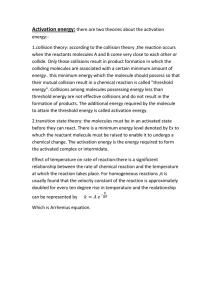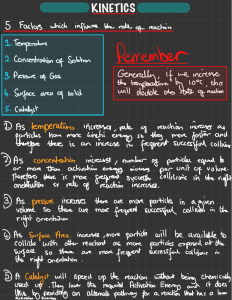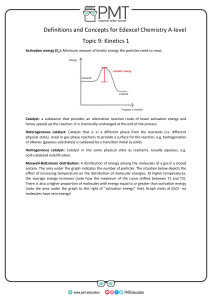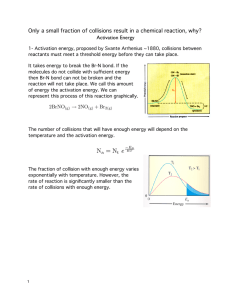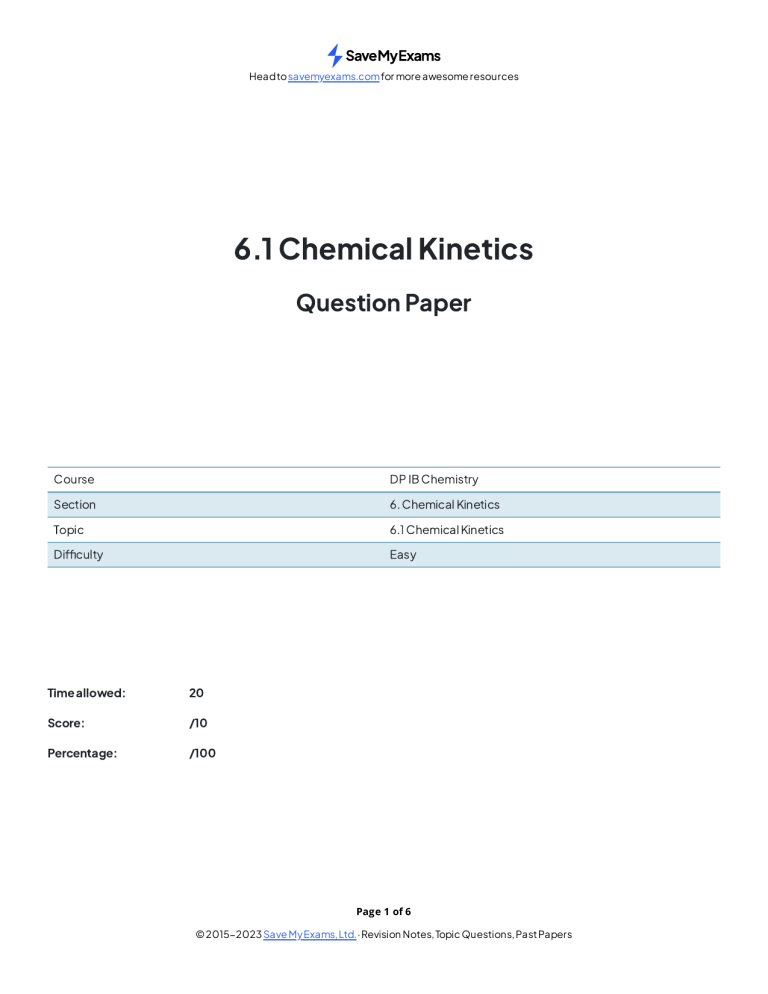
Head to savemyexams.com for more awesome resources 6.1 Chemical Kinetics Question Paper Course DP IB Chemistry Section 6. Chemical Kinetics Topic 6.1 Chemical Kinetics Difficulty Easy Time allowed: 20 Score: /10 Percentage: /100 Page 1 of 6 © 2015-2023 Save My Exams, Ltd. · Revision Notes, Topic Questions, Past Papers Head to savemyexams.com for more awesome resources Question 1 Which of the following factors can affect the value of the activation energy of a reaction? 1 the presence of a catalyst 2 changes in temperature 3 changes in the concentration of the reactants A. 1 only B. 1 and 2 only C. 3 only D. 1, 2 and 3 [1 mark] Question 2 The oxidation of butadiene, CH2=CHCH=CH2, using air or oxygen, produces the molecule crotonaldehyde, CH3CH=CHCHO. One method of oxidation is to pass a mixture of butadiene and oxygen through a hot aqueous solution of palladium(II) ions, Pd2+(aq), which catalyse the reaction. Which statement about the action of the Pd2+(aq) ions is not correct? A. Pd2+(aq) lowers the activation energy for the reaction B. Pd2+(aq) increases the energy of the reacting molecules C. When Pd2+(aq) is used, the reaction proceeds by a different route D. Changing the concentration of the Pd2+(aq) affects the rate of oxidation [1 mark] Page 2 of 6 © 2015-2023 Save My Exams, Ltd. · Revision Notes, Topic Questions, Past Papers Head to savemyexams.com for more awesome resources Question 3 The Maxwell-Boltzmann energy distribution curve below describes a mixture of two gases at a given temperature. For a reaction to occur between the gaseous molecules, they must collide with sufficient energy. Of the two activation energy (Ea) values shown, one is for a catalysed reaction, the other for an uncatalysed one. When a catalyst is used, which pair of statements is correct? A Ea1 uncatalysed reaction fewer effective collisions Ea2 catalysed reaction more effective collisions B Ea1 catalysed reaction fewer effective collisions Ea2 uncatalysed reaction more effective collisions C Ea1 uncatalysed reaction more effective collisions Ea2 catalysed reaction fewer effective collisions D Ea1 catalysed reaction more effective collisions Ea2 uncatalysed reaction fewer effective collisions [1 mark] Question 4 Ammonia is manufactured using the Haber process, which is represented by the following equation: N2 (g) + 3H2 (g) ⇌ 2NH3 (g) ∆H = –93 kJ mol–1 What happens to the rate of the forward and backward reactions when the temperature is increased? A. there is no effect on the backward or forward rate B. both forward and backward rates increase C. the forward rate only increases D. the backward rate only increases [1 mark] Page 3 of 6 © 2015-2023 Save My Exams, Ltd. · Revision Notes, Topic Questions, Past Papers Head to savemyexams.com for more awesome resources Question 5 Why does a mixture of hydrogen gas and bromine gas react together faster at a temperature of 500 K than it does at a temperature of 400 K? 1 a higher proportion of effective collisions occurs at 500 K 2 hydrogen molecules and bromine molecules collide more frequently at 500 K 3 the activation energy of the reaction is lower at 500 K A. 1 only B. 1 and 2 only C. 3 only D. 1, 2 and 3 [1 mark] Question 6 When the pressure of a fixed mass of gaseous reactants is raised at a constant temperature, the rate of reaction increases. Which of the following statements explain this observation? 1 raising the pressure lowers the activation energy 2 more molecules have energy greater than the activation energy at the higher pressure 3 more collisions occur per second when the pressure is increased A. 1 only B. 1 and 2 only C. 3 only D. 1, 2 and 3 [1 mark] Page 4 of 6 © 2015-2023 Save My Exams, Ltd. · Revision Notes, Topic Questions, Past Papers Head to savemyexams.com for more awesome resources Question 7 What is the main reason for the increase in reaction rate with increasing temperature? A. The activation energy decreases. B. The activation energy increases. C. The molecules collide more frequently. D. More molecules have an energy greater than the activation energy. [1 mark] Question 8 The diagram represents the reaction pathway for the following reaction: Z(g) + Y(g) → X(g) + W(g) What statement is true about the reverse reaction, W(g) + X(g) → Y(g) + Z(g)? A. it will have a smaller activation energy and a negative ∆H B. it will have a smaller activation energy and a positive ∆H C. it will have a larger activation energy and a negative ∆H D. it will have a larger activation energy and a positive ∆H [1 mark] Page 5 of 6 © 2015-2023 Save My Exams, Ltd. · Revision Notes, Topic Questions, Past Papers Head to savemyexams.com for more awesome resources Question 9 A student measured the rate of a reaction at two different temperatures: 40°C and 50°C. They observed that the rate of reaction roughly doubled. What explains this observation? A. raising the temperature by 10°C doubles the average velocity of the molecules B. raising the temperature by 10°C doubles the average kinetic energy of each molecule C. raising the temperature by 10°C doubles the number of molecules having more than a certain minimum energy D. raising the temperature by 10°C doubles the number of molecular collisions in a given time [1 mark] Question 10 Which statements correctly describe how a catalyst works? 1 a catalyst has no effect on the enthalpy change of the reaction 2 a catalyst increases the rate of the reverse reaction 3 a catalyst increases the average kinetic energy of the reacting particles A. 1 only B. 1 and 2 only C. 3 only D. 1, 2 and 3 [1 mark] Page 6 of 6 © 2015-2023 Save My Exams, Ltd. · Revision Notes, Topic Questions, Past Papers

